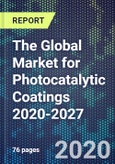Application of Photocatalytic Coatings on High-Touch Surfaces Reduces the Spread of COVID-19 in Essential Facilities Such as Hospitals, Public Transit, Daycares and Other Public Spaces
Photocatalytic self-cleaning coatings are a significant market for nanoparticulate titanium dioxide (TiO2). Nano-TiO2 surfaces (coated with 10-20nm layer of TiO2) are commercially available and have been used in (mainly in the Japanese and European markets) in water and air purification, self-cleaning glass, concrete products and a variety of coatings applications.
These coatings greatly benefit building maintenance, especially for skyscrapers, as they reduce the need for costly surface cleaning. Various types of surfaces with TiO2 can be covered to make them self-cleaning under sunlight as well as room light. Thus, surfaces based on paints, ceramics, glass, cementitious materials containing active photocatalytic titania nanoparticles have widespread applications to create environmentally clean areas within their proximity.
They can also be used to curb the spread of COVID-19 and other viruses. Photocatalytic coating are used in hospitals, acute care facilities, assisted living facilities, senior care facilities, athletic centers, schools, child-care facilities, arenas, airports, and other facilities to reduce the spread of airborne toxins and allergens, such as COVID-19 and MRSA.
Self-cleaning photocatalytic coatings utilizing UV light are currently suitable mainly for exterior use for inorganic surfaces and coatings. Photocatalytic materials operating at the wavelength of visible light are also widely studied.
Industries impacted by self-cleaning photocatalytic coatings include:
- Self-sterilising, long-lasting clear coatings that kill viruses and bacteria
- Self-cleaning architectural glass
- Self-cleaning automotive glass
- Roof coatings to to reduce pollution through the degradation of sulfur and nitrogen oxides)
- Road and tunnel coatings
- Medical (self-disinfecting coatings)
- Self-cleaning exterior paints
- Coatings for the elimination of VOCs and odours in public spaces
- Water purification
- Air purification (indoor)
- Self-cleaning solar cell coatings
Applications make use of the self-cleaning, anti-fogging, anti-microbial or water cleaving properties. In indoor environments, most surfaces, e.g. ceramic tiles, windows glass or paper, are gradually covered with organic matter such as oils, dirt, and smoke residue and become fouled. Use of photocatalytic coatings that are activated under visible light irradiation can address these issues.
Report contents includes:
- Market drivers and trends
- Latest product and technology developments
- Anti-viral and anti-microbial applications
- Photocatalytic coatings in glass, building and construction, indoor air filtration, water treatment, medical facilities
- Global market revenues, historical and forecast to 2027
- 51 company profiles; companies profiled include Advanced Materials-JTJ s.r.o., AM Technology Ltd., Daicel FineChem Ltd., Envision SQ, MACOMA Environmental Technologies, LLC, Maeda Kougyou Co. Ltd., Pureti, Swift Coat Inc., and more!
This product will be delivered within 1-3 business days.
Table of Contents
Companies Mentioned (Partial List)
A selection of companies mentioned in this report includes, but is not limited to:
- Advanced Materials-JTJ s.r.o.
- AM Technology Ltd.
- Daicel FineChem Ltd.
- Envision SQ
- MACOMA Environmental Technologies LLC
- Maeda Kougyou Co. Ltd.
- Pureti
- Swift Coat Inc.
Methodology

LOADING...








